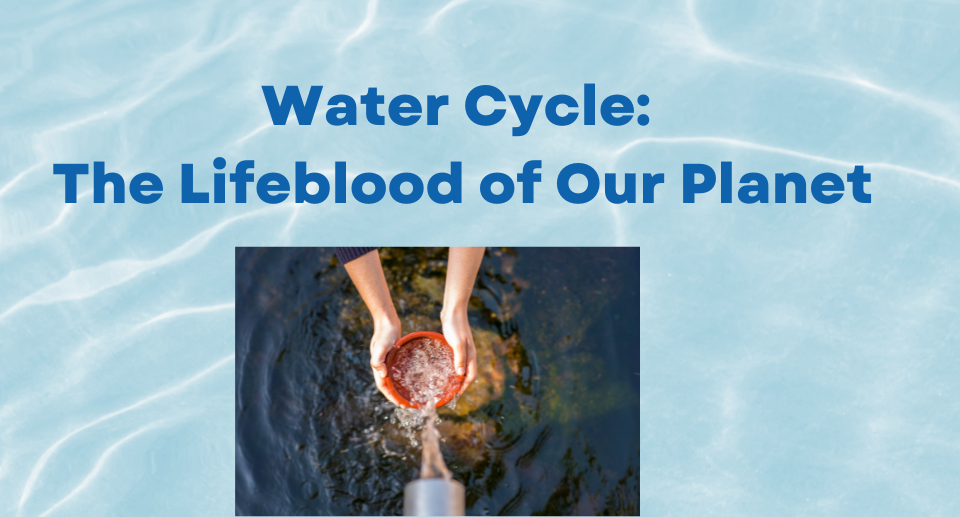Water Cycle: The Lifeblood of Our Planet

Water is an essential part of life. Imagine going just one day without water — no water to drink, no water to cook, no water to wash with. Impossible, right? Our lives, and the very existence of all living things, depend on water. Yet, how often do we stop to think about where our water comes from or how nature continually provides us with this precious resource?
This is where the Water Cycle comes in. Also known as the hydrological cycle, it’s nature’s way of recycling water, ensuring that we, along with every other living organism, have the water we need to survive. The water cycle doesn’t just quench our thirst or sustain our crops — it plays a pivotal role in maintaining environmental balance, keeping ecosystems thriving, and preserving life on Earth. Let’s dive into the fascinating process of the water cycle and explore its importance in the larger context of the ecosystem.
What is the Water Cycle?
At its core, the water cycle is a continuous movement of water between the Earth and the atmosphere. This journey involves several stages: evaporation, condensation, precipitation, and collection. Each stage contributes to recycling and redistributing water across different parts of the planet.
- Evaporation: This is the starting point. When the sun heats up water bodies like oceans, rivers, lakes, and even moisture from plants, the water turns into vapor. This process is called evaporation. Have you ever noticed how a puddle disappears after the sun comes out? That’s evaporation in action! Water from the Earth’s surface changes from liquid to gas, rising into the atmosphere.
- Condensation: After water vapor rises, it cools down as it reaches higher altitudes. Cooler temperatures cause the vapor to condense into tiny water droplets, forming clouds. This is the process of condensation. You’ve probably observed it when you see fog or when your cold drink causes water droplets to appear on the outside of the glass. In nature, clouds are essentially large collections of condensed water vapor.
- Precipitation: Once the clouds fill up with enough condensed water, they become heavy. This leads to the next stage, precipitation. Precipitation can take many forms — rain, snow, sleet, or hail — depending on the temperature of the surrounding air. This is how water returns to the Earth’s surface, replenishing rivers, lakes, oceans, and soils.
- Collection: The water that falls from the sky doesn’t just disappear. It either seeps into the ground (replenishing groundwater) or it flows back into larger bodies of water like rivers and oceans. This is known as the collection stage. The collected water eventually evaporates again, and the cycle continues endlessly.
The Importance of the Water Cycle in Ecosystem
The water cycle isn’t just about moving water from one place to another. It’s essential for keeping our environment in balance. Without it, life on Earth would cease to exist. Here’s why:
- Regulating Climate: Water vapor plays a significant role in regulating the Earth’s temperature. When water evaporates, it absorbs heat, and when it condenses into clouds, it releases that heat back into the atmosphere. This transfer of energy helps moderate temperatures, preventing extreme heat or cold in different parts of the world.
- Supporting Plant and Animal Life: Plants, animals, and humans all rely on the water cycle for survival. Plants need water from the soil to carry out photosynthesis, the process by which they produce food. Without precipitation from the water cycle, plants would wither and die. Animals, too, rely on fresh water sources for drinking, while humans use water for agriculture, industries, and personal consumption.
- Replenishing Freshwater Resources: The Earth has limited freshwater resources. Although oceans cover about 71% of the Earth’s surface, only 2.5% of the Earth’s water is freshwater, most of which is trapped in glaciers and ice caps. The water cycle ensures that rivers, lakes, and underground aquifers are continuously refilled with fresh water, making it available for us to use.
Preventing Droughts and Floods: A healthy water cycle distributes water evenly across the planet. If the balance is disrupted, regions may experience droughts, where no precipitation occurs for extended periods. On the other hand, too much precipitation can cause flooding. The cycle helps maintain equilibrium by ensuring that no single area is consistently deprived of or overwhelmed by water.
Impact of Human Activity on the Water Cycle
While the water cycle is a natural process, human activities can have a profound impact on it. Deforestation, urbanization, pollution, and climate change are all factors that affect the cycle’s efficiency.
- Deforestation: Trees play a crucial role in the water cycle by releasing water vapor through a process called transpiration. When forests are cut down, less water vapor enters the atmosphere, potentially reducing rainfall in certain areas.
- Urbanization: As cities expand, natural landscapes are replaced with concrete and asphalt. This prevents water from seeping into the ground, leading to a higher risk of floods and reduced groundwater levels.
- Pollution: Water bodies polluted with chemicals and waste disrupt the quality of water that enters the water cycle. Pollutants can also travel through precipitation, leading to acid rain, which harms plants, animals, and human-built structures.
- Climate Change: Global warming intensifies the water cycle, causing more extreme weather patterns. Higher temperatures lead to increased evaporation and, in turn, heavier rainfall and more powerful storms. Conversely, some regions are facing prolonged droughts due to changing precipitation patterns.
Why We Should Protect the Water Cycle
Given how deeply the water cycle influences our daily lives and the environment, it’s clear that protecting this natural system is crucial. We all have a role to play in conserving water and ensuring the sustainability of our ecosystems.
- Reduce Water Waste: Simple actions like fixing leaks, taking shorter showers, and using water-efficient appliances can make a significant difference.
- Support Reforestation and Greenery: Planting trees and supporting efforts to restore forests can help maintain a healthy water cycle by promoting evaporation and precipitation.
- Preserve Water Bodies: Avoid polluting rivers, lakes, and oceans with chemicals and plastics. These bodies of water are critical parts of the cycle and need to remain clean to support life.
- Conserve Groundwater: Use water responsibly, especially in areas where groundwater is the main source of fresh water. Excessive pumping can deplete aquifers, making it difficult to sustain local
communities.
Conclusion
The water cycle is one of nature’s most vital processes, allowing life to thrive on Earth. From the moment water evaporates from the oceans to the time it falls as rain or snow and returns to rivers and lakes, the cycle continues its work, silently and steadily. By understanding and appreciating the water cycle, we not only gain insight into how nature sustains us but also recognize our responsibility to protect and preserve this delicate system. Our actions today will determine the future availability of water for generations to come.

